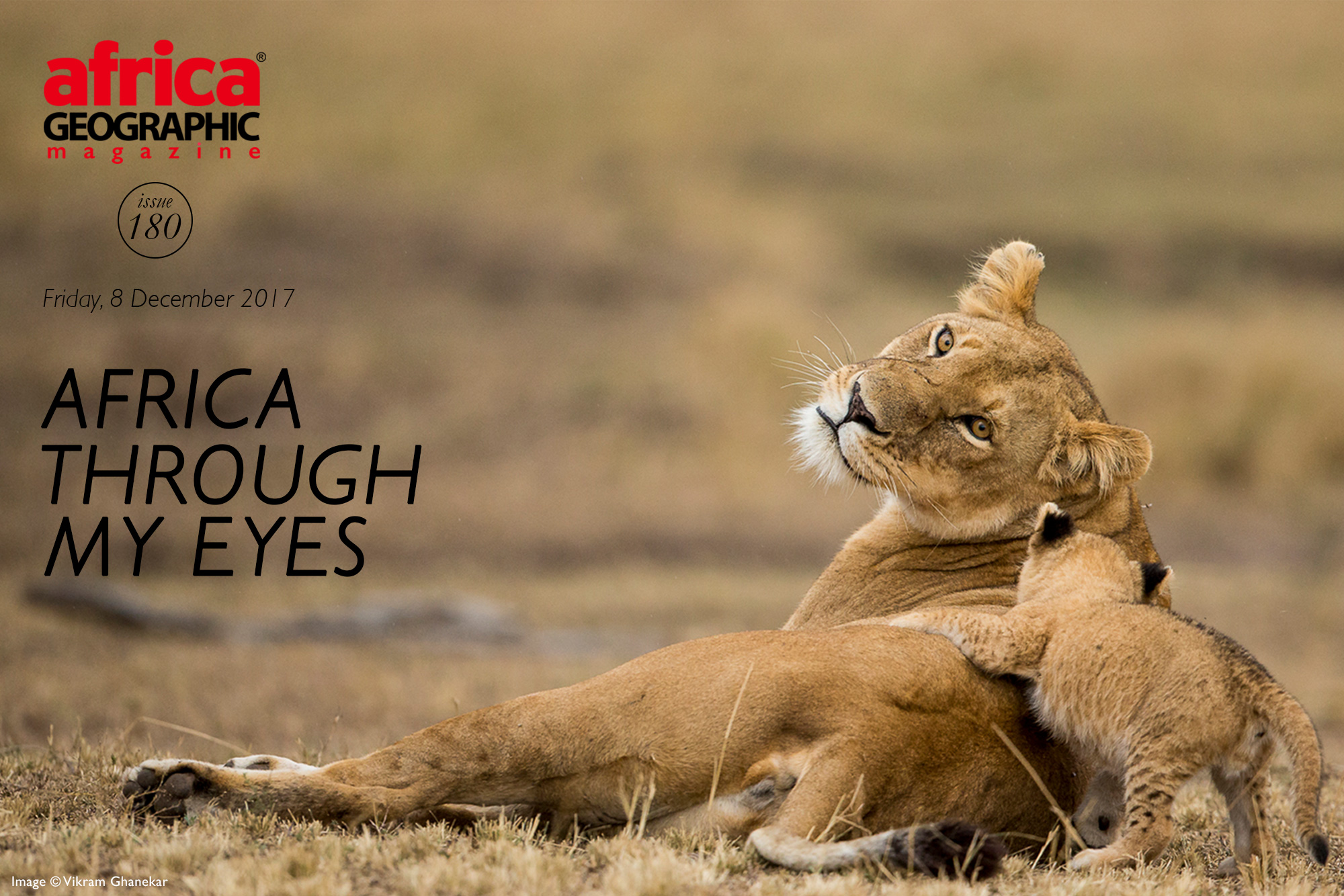
Discovering Africa through the lens of a wildlife photographer

Dr Vikram Ghanekar’s journey into the world of wildlife photography began almost a decade ago. His first venture into Africa took place in 2008, and he immediately learned a fundamental reality: you may have the best equipment, but you need to know how to use it properly.
Needless to say, after a few workshops and learning from Big Cat Diary presenters, Jonathan Scott and Jackson Looseiya, he has proved to be a highly-talented photographer. Read about his mobile safari experiences below, and enjoy his own exquisite photographs that are a testament to his phenomenal ability behind the lens.
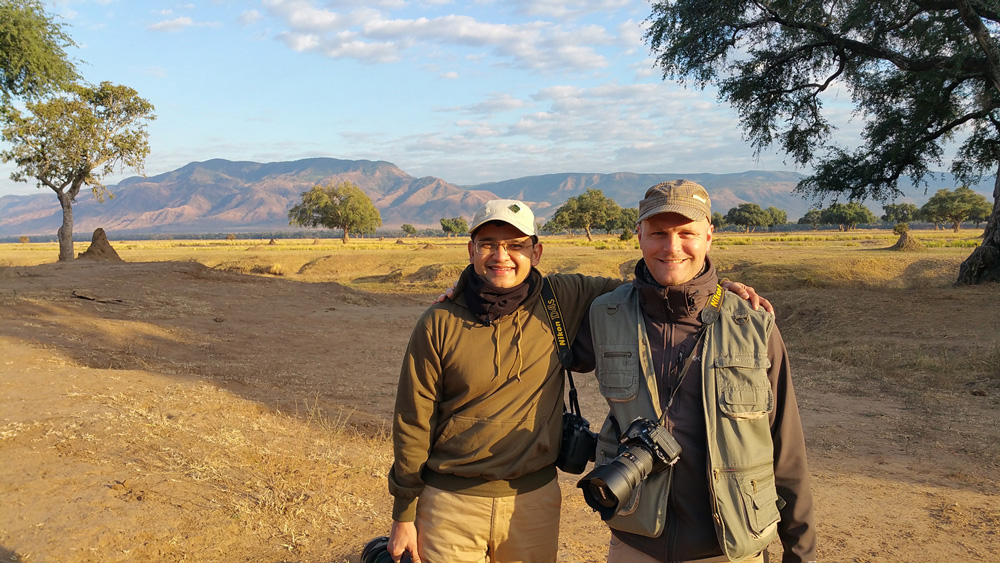
“Safari is one adventure where you meet like-minded people from across the world and forge friendships that last a lifetime. This photo was taken in Mana Pools National Park, Zimbabwe with my friend and ace photographer Morkel Erasmus.
The magnificent Maasai Mara
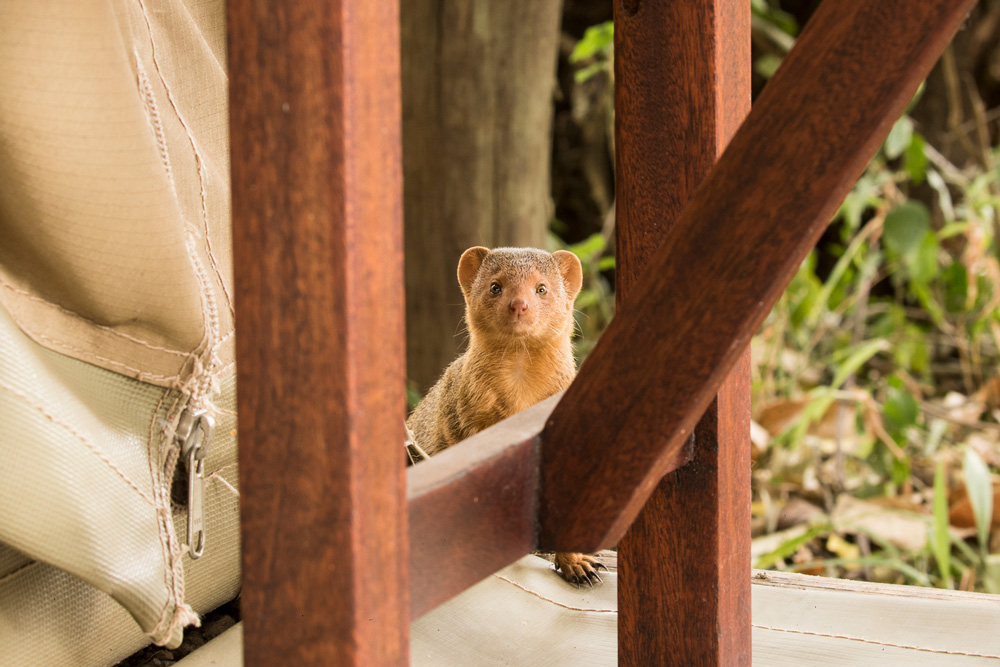
“While on safari in the Maasai Mara National Reserve, Kenya, I was sitting on the ground just outside my tent on the banks of the Talek River. It was mid-afternoon, and everything was tranquil. I was taking in the view when I heard a rustling noise behind me. As I turned, a tiny head popped up from behind my camp chair. A dwarf mongoose! The mongoose was probably equally surprised to find me sitting there. But it was also curious and kept staring at me with wide eyes. Fortunately, my camera was lying close by, and I could fire off a few frames before it decided to join its mates scurrying around in the surrounding bushes.

“On one occasion, while out on a drive, we came across Malaika, a famous cheetah mother, along with her three cubs. The cubs were playing with each other and enjoying a game of rough and tumble. Suddenly, they froze, locking their gaze on some movement in the distance. Before we could realise what was happening, the cubs were off in a flash. In a few brief moments, they had caught a very young Thomson’s gazelle fawn. The fawn had been hiding in tall grass, but something had disturbed it, and its movement had drawn attention of the wrong kind.
“The cheetah cubs didn’t kill it immediately, and while the fawn kept trying to run away, the cheetahs took turns to bring it down. This went on for a while under the watchful eyes of their mother. It was hard to look at, but it was nature at work. Finally one of the cheetah cubs delivered the death blow to the now battered fawn. End of innocence, in the literal sense for the innocent young fawn, and end of innocence for the young cheetahs as they turned into adults, capable of killing on their own.
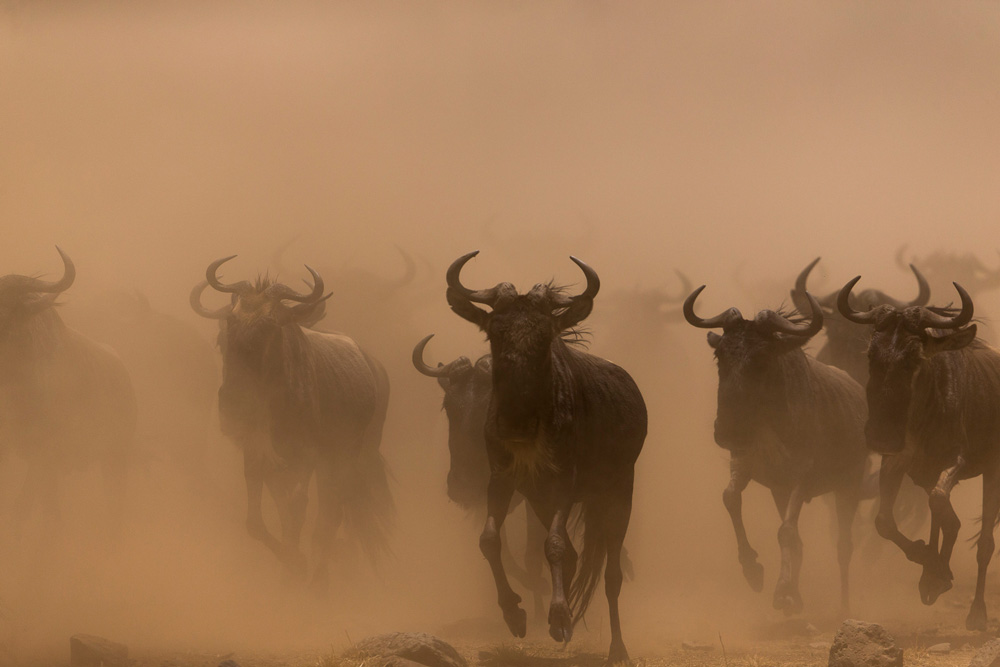
“The Maasai Mara-Serengeti ecosystem is famous for its wildebeest migration. One of the most anticipated events in this drama of life is the crossing of the Mara River. On one hot day in September, my family and I were waiting patiently along the banks of the river as a large herd of wildebeest had gathered close by. The atmosphere was tense in anticipation as to when the wildebeest would start crossing. As it so happened, something suddenly spooked the wildebeest, and instead of heading down into the river, the whole herd turned around and thundered away, raising a massive cloud of dust. As the wildebeest stampeded out of the haze, I tripped the shutter of my camera, creating a very different look to the photo.

“Young ones of any species are excellent subjects for photography. What’s even better is when they are lion cubs – especially as adult lions, more often than not, will be found doing precisely nothing. I was observing these young lion cubs playing with each other and their mother. The mother’s tail, of course, was a hot favourite among the cubs, as they all tried to catch hold of the “toy”.
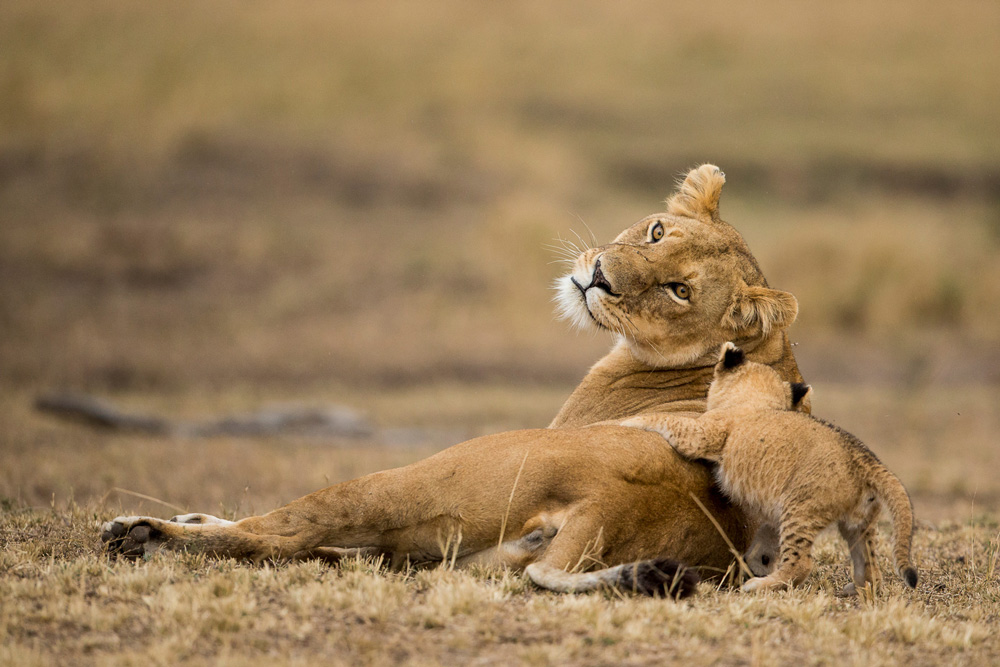
“In another scene, the lion cubs were busy playing with each other, jumping over their mother. I wanted to capture interaction between the mother and her young ones, and the opportunity arose when she looked back as one of the cubs started to climb over her.
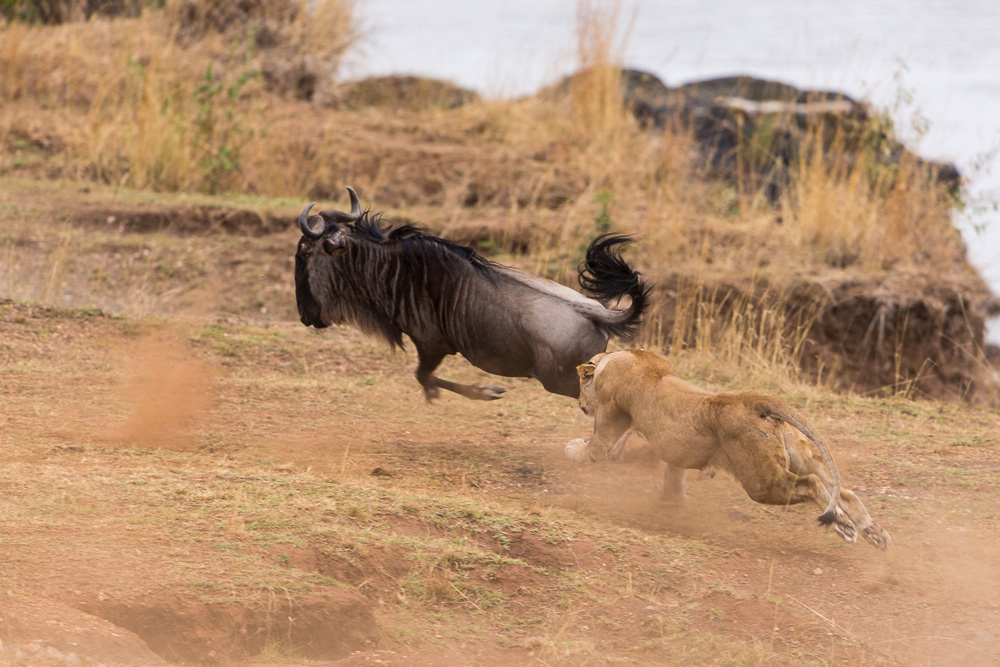
“On one of the drives, we came across a pride of lions lounging along the banks of the Mara River. The lionesses were quite relaxed and seemed intent on sleeping the afternoon off. Suddenly, a small herd of wildebeest wandered close to the bank. Anticipating a crossing, everybody in the vehicle perked up. The wildebeests’ movement did not go unnoticed. The lionesses that were lounging, half asleep, suddenly were alert and looking keenly towards the wildebeest. As the wildebeest started crossing, one of the lionesses took off. All the hell broke loose with wildebeest scattering in all directions.
“The lioness selected her victim and gave chase. The poor animal abandoned its plan of crossing and instead turned away from the river with the lioness in hot pursuit. Fortunately, I was able to fire off my camera, capturing the moment as she was almost on top of her prey. The drama did not end well for the wildebeest.

“It was early one morning as the sun was rising. I positioned our vehicle so that the impalas that were feeding on a ridge were silhouetted against the pre-dawn light. The next thing, a safari vehicle crossed the same ridge, allowing me to take a few quick shots. The people standing in the vehicle with their heads popping out from the roof added to that “ultimate safari in Africa” feel to the scene.
The wonders of Khwai

“Mobile safari operations require substantial logistical support. As a guest, one doesn’t fully realise the immense hard work that goes on behind the scenes. While on a mobile safari in Botswana, we were shifting camps from Moremi Game Reserve to the Khwai Concession. The staff had taken down the camp after we had left, packed all the equipment in their truck and had made the journey through difficult terrain to reach our next campsite at Khwai. When we arrived at Khwai, they were in the process of setting up camp. As I walked through the campsite, I asked this staff member if I could take her photo as she worked. She obliged by posing for me amid all the camping equipment.
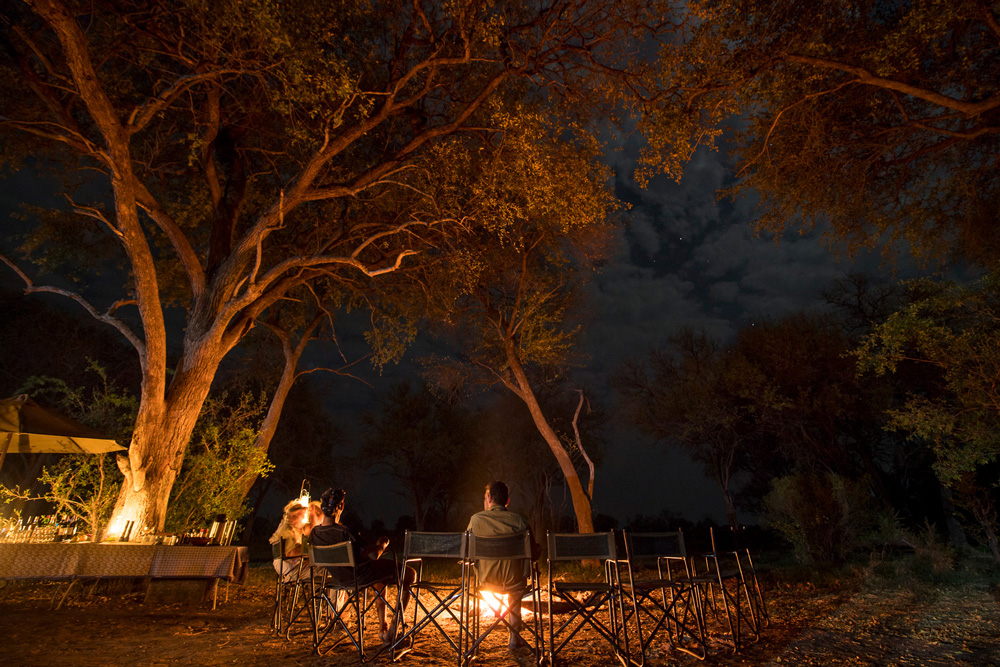
“Sitting around the campfire, or “BushTV” as safari-goers call it, is an essential part of the safari camping experience. This is the place where the day’s adventures are recounted, anecdotes of previous safaris are exchanged, and interesting conversations are initiated – which tend to continue over to the dinner table. This is also the place just to sit and stare into the fire and contemplate. There is no better way to spend an evening where acquaintances are transformed into long-lasting friendships.
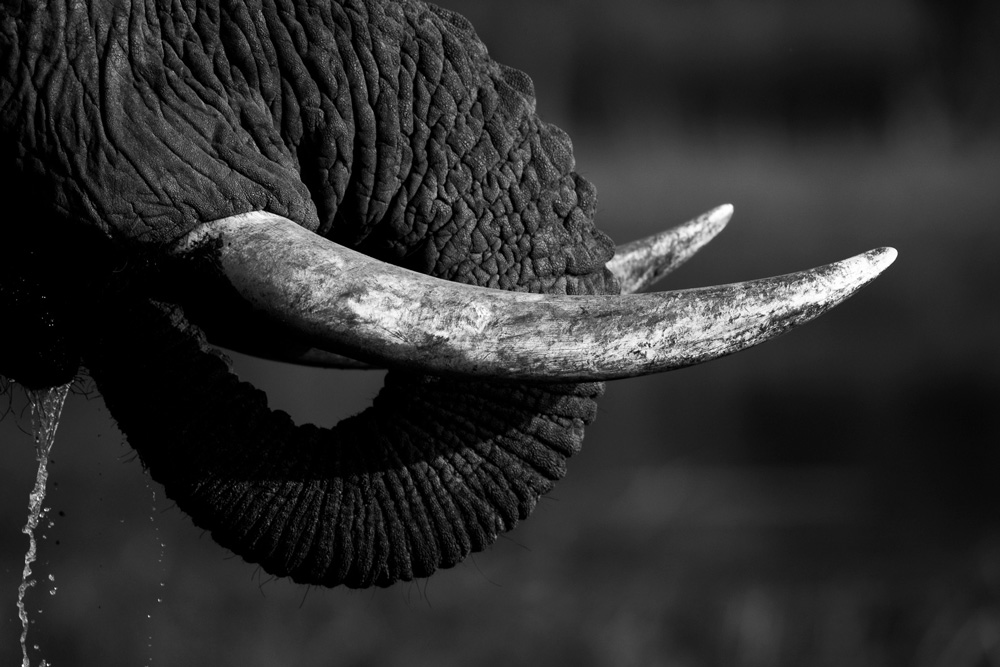
“Elephants are my favourite subjects. There is something majestic and mysterious about these intelligent animals. I find it hard to digest the thought of killing these gentle giants for their tusks, for something as insignificant as a trinket. Ivory belongs to elephants and no one else.
“In this photograph, I tried to capture the beautiful patterns of this elephant bull’s tusks, set on the background of his wonderfully textured trunk.
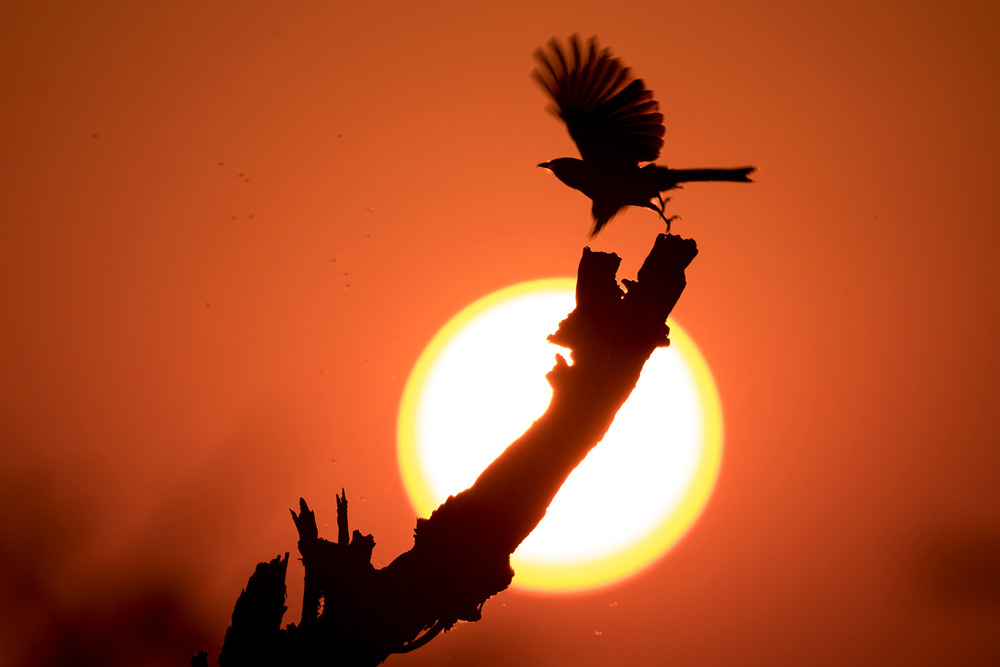
“Photographing iconic animals of Africa is addictive. Their photos are bound to impress the viewer and evoke emotions. However, the skill of a nature photographer lies in taking an ordinary subject and turning it into an extraordinary photo.
“We had stopped near the Khwai River for sundowners after an eventful afternoon spending time with a pack of wild dogs and a female leopard. As the sun was setting, I noticed a fork-tailed drongo sitting on a dead tree stump. I positioned myself to get that stump between my camera and the sun, trying for a beautiful silhouette of this widespread bird. As luck would have it, the drongo took off just as I tripped the shutter, making the photo even better than I had anticipated!

The trunked giants of Mana Pools
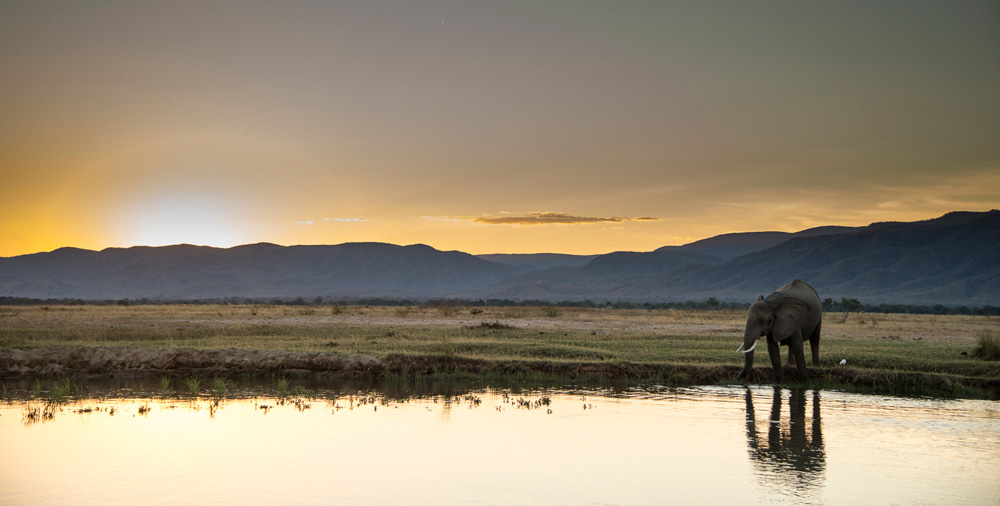
“Mana Pools National Park in Zimbabwe is an extraordinary place. It’s one of the very few parks in Africa where you are allowed to walk on your own among the big game. In the park there is an area called Mana Mouth where the Mana River meets the mighty Zambezi, creating a vast floodplain. This photo was captured at Mana Mouth one evening when a breeding herd of elephants was feeding on one of the exposed islands within the Zambezi. As the sun dipped just below the escarpment on the Zambian side, the sky took on a beautiful glow, adding drama to an already exquisite scene.

“The park is dominated by giant Faidherbia albida or ana trees. In the dry season, the undergrowth completely dies out, leaving very little food for herbivores on the ground. Elephants, on the other hand, still have access to feed in the form of branches and the delicious seed pods from the ana trees. However, the trees are so tall that reaching those branches is a big stretch, even for a bull elephant. Fortunately, the Mana elephants have learnt to adapt to this situation, and by extending every part of their body in such a way, the tip of their trunks can reach the ana tree’s leaves. A couple of bulls can even heave themselves up onto their hind legs to reach the upper branches while others have to stick with the “Mana stretch” as demonstrated in this photograph.
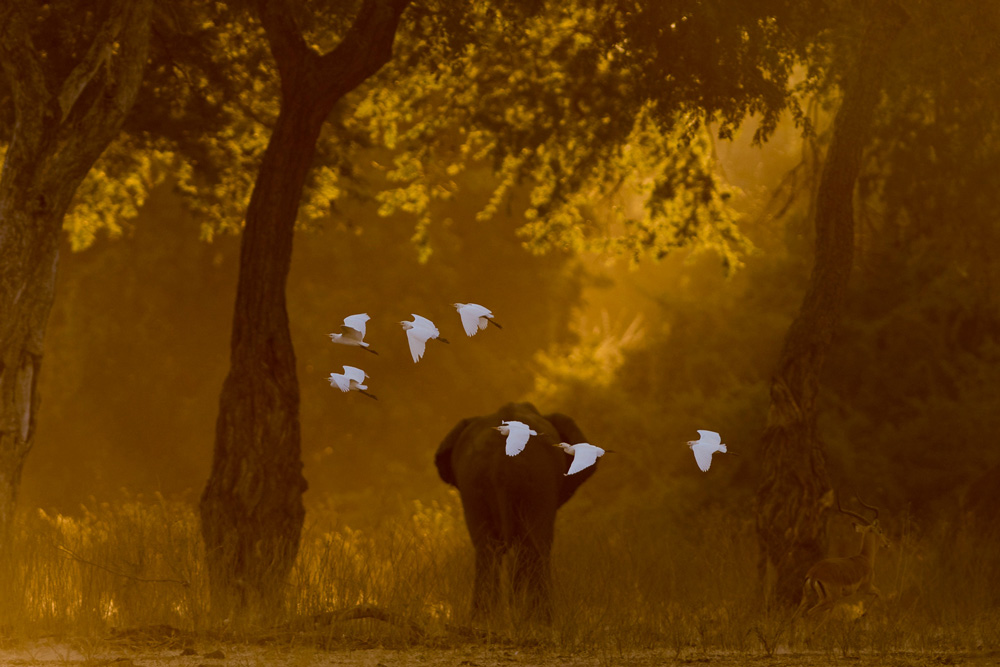
“In a different elephant sighting in Mana Pools, my friends and I were following a bull elephant on foot. The idea was to capture the subject in the beautiful evening light as the sun’s rays filtered through the ana trees. There was a flock of cattle egrets nearby, feeding on insects disturbed by the elephant. Suddenly the egrets took off! Their flight took them right across the feeding elephant, and I was able to capture that exact moment in this photograph.

Okavango Delta
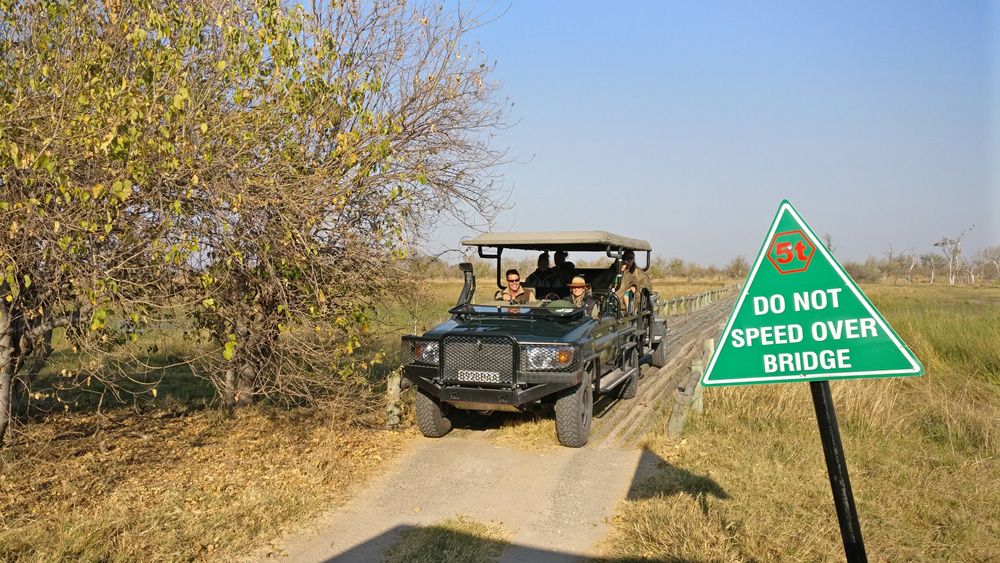
“Driving through the Okavango Delta in Botswana is a challenging experience. With water levels fluctuating according to the ebb and flow of the river, one may find your path entirely blocked by floodwaters. Certain areas that remain submerged year-round are accessed by crossing some interesting bridges. Constructed entirely out of wooden logs, crossing them is an adventure in itself requiring a lot of careful driving. Yet I was surprised to see signs “Do not speed over the bridge”, indicating some not-so-smart humans and their vehicles have ended up in the floodwaters not too infrequently!
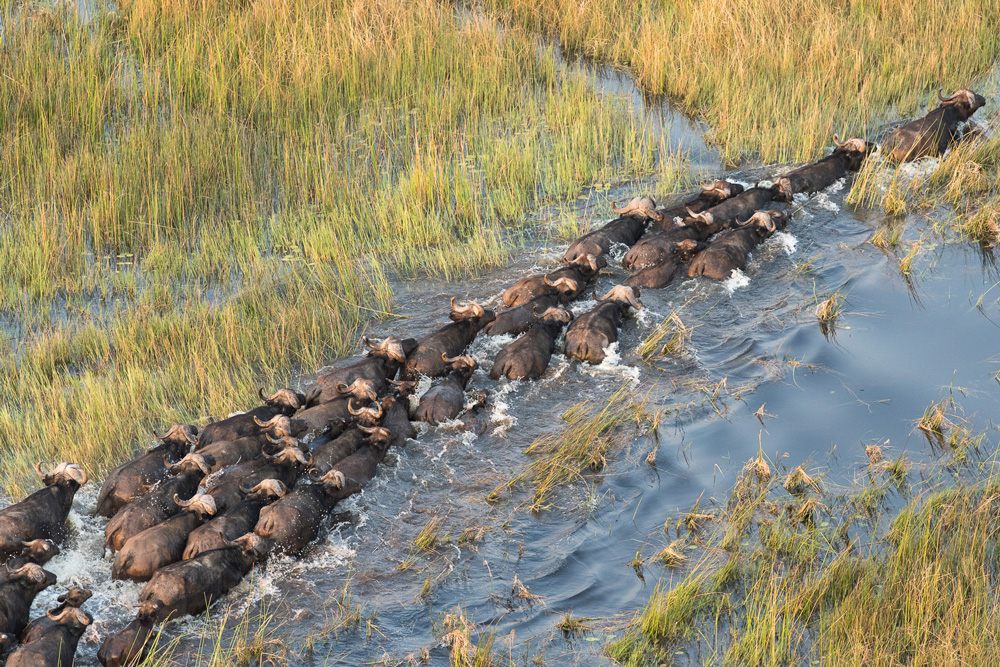
“The delta is a magical place. To experience it from the air is even more magical. When an opportunity to fly over the delta in a helicopter presented itself, I grabbed it with both hands. We had the doors of the helicopter removed, allowing me to take photos from my seat without hindrance. We took off from Maun and were soon flying over Chief’s Island, a part of the delta teeming with wildlife. We came across a large herd of buffalo. As we flew lower, the buffaloes took off through the waters. I took a few photos, composing them in such way that the herd was crossing the frame diagonally, which I thought was much better composition-wise, rather than having them horizontally cross the frame.
South Luangwa
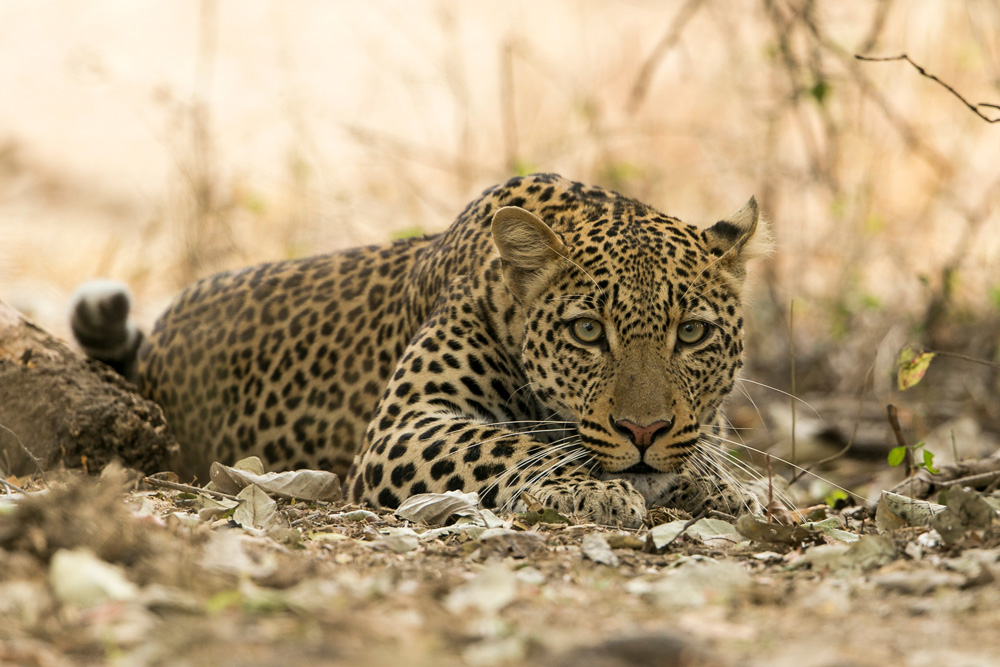
“South Luangwa National Park in Zambia is famous for its leopard sightings. Being one of the very few parks in Africa that allows night drives, it is one of the best places to spot leopards. While on safari in South Luangwa, I came across this young male leopard. He saw our vehicle, but instead of running away as leopards are known to do, he merely flattened himself against the ground, allowing me to capture his portrait.

“South Luangwa is the home of walking safaris, allowing tourists to get close to dangerous game on foot. Guides are comfortable taking guests near to big herds of buffalo – considered one of the most dangerous animals in Africa. But lonely old males, or “dagga boys”, are a different matter altogether. These old bulls do not take too kindly to being approached. Separated from herds, old and past their prime, their only response to a perceived threat is to attack. The way they look at you with their beady, bloodshot eyes, sends a shiver down your spine. They certainly give you a look as if you owe them a big debt!
Sensational Savute

“The baobab tree is probably the most iconic tree in Africa. While on our way to Savute on a mobile camping trip in Botswana, our guide, Brian made a special stop under this ancient baobab. I couldn’t resist taking a photo of the tree with my mobile phone to emphasise the incredible size of this tree, completely dwarfing us and our cars.
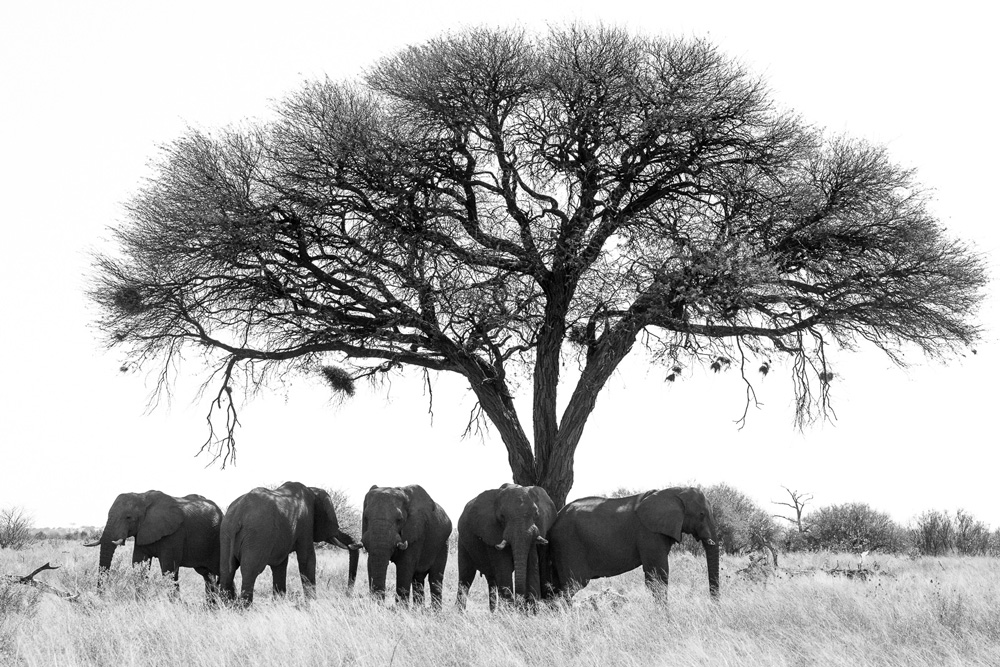
“Savute is a harsh, dry place situated in the heart of the Kalahari with very little surface water – and a playground for colossal bull elephants. On a particularly hot day, I found a group of elephants having a nap under an acacia tree. The elephants had formed a semicircle under the tree, allowing me to take a very different photo. A B&W conversion emphasised the composition, taking away the effects of the harsh sunlight.
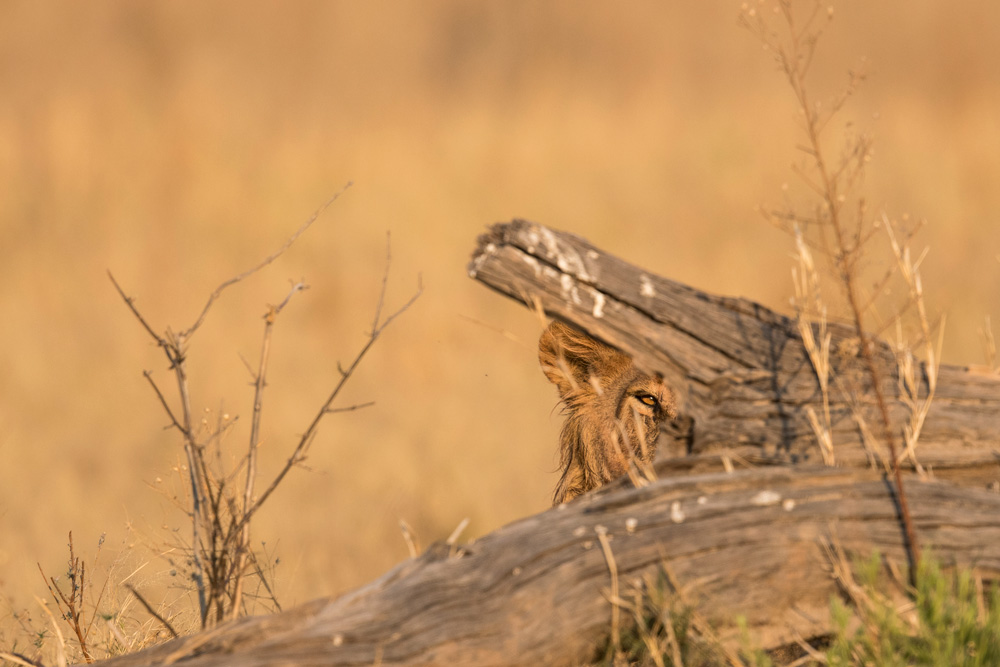
“Another fantastic sighting was of this coalition of four male lions who had brought down a buffalo, feeding on it throughout the night. In the morning, we found two of them still feeding, while the other two were lying in the shade – the one was in the shadow of a large fallen tree. Then we noticed a pair of jackals arrive, looking for scraps. This drew the attention of the dozing lion by the tree. He woke up and stared at the jackals partially through a gap in the tree, and that’s when I captured this photo, revealing just the lion’s eye while the rest of his head and body remained hidden.

“It was the last day of our mobile camping safari in Savute, and we had left our campsite early in the morning to make our way back to Maun slowly. There is a hill in Savute called “Leopard Rock” in an otherwise very flat landscape. Despite its name, our previous efforts to locate the animal it is named after had failed miserably. Our guide decided to take one last chance as the hill was near to where we were heading.
“When we reached “Leopard Rock”, another vehicle was already there. A lovely couple in the vehicle informed us that they had seen a female leopard climbing into a ravine just a few minutes ago. Maybe luck had decided to smile on us after all… But what we were about to experience was unimaginable.
“After a painfully long time, a beautiful female leopard came out from behind a rock and settled down. But that wasn’t all. She called out softly when suddenly a tiny head popped out from behind the rock. A cub! The cub came out and sat down by its mother. We are ecstatic. The mother licked her cub for a few minutes and then climbed down. Halfway down, she called out for her cub, encouraging it to follow. But the cub was hesitant. It wasn’t going to leave its cosy home behind.
“The mother realised her instructions were not being followed, so she went back and gently picked the cub up in her mouth and climbed down the rock. We could not believe our luck! She came close to our vehicle, crossing the road behind us, still carrying the cub in her mouth. Soon she disappeared into the thick bushes on the other side. Unbelievable! We could not have asked for a better end to our safari in Botswana.”
For accommodation options at the best prices visit our collection of camps and lodges: private travel & conservation club. If you are not yet a member, see how to JOIN below this story.
About the author
 Vikram Ghanekar is a consultant surgical oncologist at SGM Hospital in Chuplin, India. Wildlife and nature photography has always fascinated him and has led him to experience and photograph Africa’s spectacular wildlife. He has an astounding ability to capture the emotion that should be reflected in a photograph.
Vikram Ghanekar is a consultant surgical oncologist at SGM Hospital in Chuplin, India. Wildlife and nature photography has always fascinated him and has led him to experience and photograph Africa’s spectacular wildlife. He has an astounding ability to capture the emotion that should be reflected in a photograph.
“If somebody asks me what my favourite animal to photograph is, it has to be the elephant. Elephants fascinate me more than any cat. Their intelligence, their family bonds, their social interaction is just fantastic to watch and photograph,” he says.
To comment on this story: Login (or sign up) to our app here - it's a troll-free safe place 🙂.![]()






